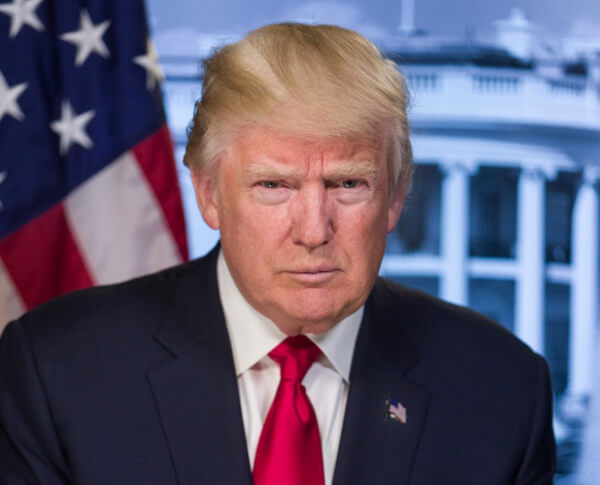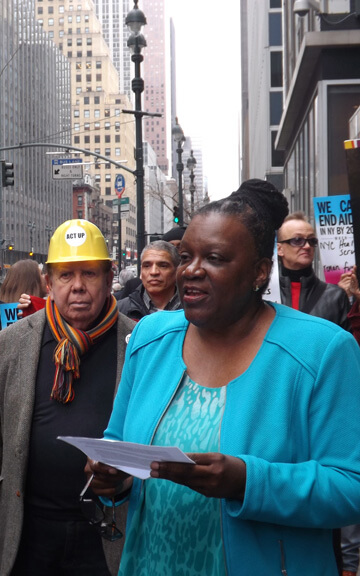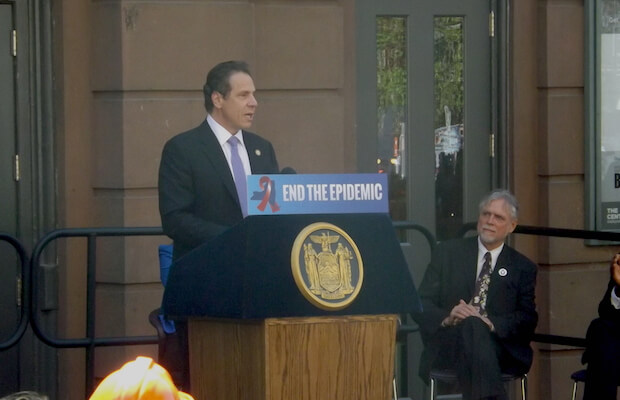BY NATHAN RILEY | In the closing hours of the legislative session, Governor Andrew Cuomo signed off on an approach to medical marijuana legislation that will allow its use under carefully controlled circumstances.
The law that was adopted as a result — reflecting his bottom lines but not those of Staten Island Independent Democratic Conference Senator Diane Savino or Manhattan Democratic Assemblyman Richard Gottfried, the bill’s sponsors — will prohibit smoking raw marijuana but permit the use of vaporizers and edible marijuana.
This limitation, imposed at the governor’s insistence, may explain the nearly unanimous support for the bill. It passed the Assembly by a lopsided majority of 113 to 23 and the Senate 49 to 10 — majorities that showed broad comfort with the measure among both Republicans and Democrats.
Politics trumped science, qualifying illnesses not yet clear, costs will be high, reform advocates say
People living with HIV/AIDS may apply to become an eligible patient if their doctor obtains certification from the state health department to prescribe medical marijuana. Two to four hours of training will be required for doctors seeking such certification, and they must be credentialed in a specialty for treating the patient’s qualifying serious illness. Prescriptions can only be written by the doctor actually providing treatment to the patient.
The Drug Policy Alliance, which has emerged as a critic of the Cuomo bill, pointed out that its mandated training is “a requirement for which there is only one other precedent in all of US medicine.” That stipulation, the group argued in a Daily News op-ed, represents “an extraordinary level of intrusion into the doctor-patient relationship.”
The Alliance provided funds and technical support to a broad coalition of patients, doctors, AIDS organizations, citizen groups, and drug treatment programs that pushed the medical marijuana issue to a successful vote in Albany.
Mischa Sogut, a spokesman for Gottfried, said the guidelines for how seriously ill a patient must be and what hoops the doctor must go through to prescribe the non-smokable marijuana will be developed through a regulatory process led by the state health commissioner. But Alliance leaders Julie Netherland and Gabriel Sayegh, the op-ed’s authors, argued that “the bill gives the governor’s administration sole discretion” and that “politics, not science, drove the final agreement.”
At the heart of that concern was the governor’s demand that the provision for a medical advisory board to work in tandem with the health commissioner in developing guidelines be eliminated. As a result, Cuomo’s appointee will call the shots without any outside oversight from medical experts unencumbered by political allegiance.
At this time, it is not clear how severe the symptoms of people contending with AIDS, cancer, or post-traumatic stress disorder will have to be in order for them to qualify for medical marijuana treatment.
The implementation procedures for the new law mean that marijuana may not be available for qualifying patients any sooner than the end of 2015. An early draft of the law contained emergency provisions that would have allowed the health commissioner to waive the regulatory niceties to get marijuana into the hands of those with the greatest need immediately.
That option is no longer there, and obtaining medical marijuana approved by other states is also not in the cards. Erik Williams, director of government and community affairs for Gaia Plant-Based Medicine, a leading purveyor of medical marijuana in Colorado, said “it’s not realistic to expect interstate transportation of marijuana medicine,” noting that federal drug laws bar its movement across state lines.
Cuomo’s intervention in the marijuana debate was intended to convey his concern that the drug is dangerous and can be a “gateway” to harder drugs; controversially, he even linked its use to heroin addiction. Apparently concerned about the political downside of appearing to send the wrong message, the governor demanded numerous changes in the legislation under consideration and emphasized his determination not to see medicine diverted to non-medical, recreational uses.
Even as Cuomo took a stand against the availability of drugs for the state’s youth, the presence of parents lobbying for medical marijuana with their children sent a very different message. Just before the Assembly passed the governor’s bill, an 11-year-old lobbying in the State Capitol with her mother had a seizure that suppressed her breathing. EMTs who came to her rescue gave her oxygen and an injection of a valium-like narcotic that restored her breathing to normal after a one-hour nap. She was able to continue lobbying with her mother and fellow activists. Her mother and her doctors believe that marijuana would prevent these frightening seizures from happening.
Gottfried explained his advocacy of the legislation in terms of such incidents.
“I am especially concerned about the very young children with a devastating, severe life-threatening form of epilepsy called Dravet Syndrome,” he said. “A particular form of medical marijuana gives them almost complete relief. Some of these little children will die waiting for the law to be implemented.”
Gottfried first introduced a medical marijuana bill in 1997, and as chair of the Assembly Health Committee has been at the center of campaigns to pass this law.
Sayegh, who is the Alliance’s New York State director, acknowledged, “This is a huge step for patients in New York who will benefit from this legislation, and without question, today would not be possible but for the dedicated and sustained organizing work by patients, families, and advocates.”
He added, however, “This bill is far from perfect. Many of the limitations in this bill — like the restrictions on conditions and physician-patient relationships — are unnecessary and not supported by the science. And we know that overly restrictive medical marijuana programs leave patients behind.”
Savino chose to emphasize the progress made in enacting the compromise law, saying, “We celebrate this victory with the countless patients, families, advocates, health care professionals, and physicians who have all fought passionately for the safe and reliable use of medical marijuana.”
Janet Weinberg, the chief operating officer at Gay Men’s Health Crisis, thanked “my heroes and heroines in GMHC’s Action Center and the staff of Compassionate Care New York, who’ve made so many trips to Albany. This has been a long and hard fight.”
The non-smokable marijuana mandated under the law will probably be expensive. Providers must grow it in-state and indoors, and their product must then be tested at their expense at a laboratory approved by the health department. Even with that, an additional 7 percent tax will be tacked on to the price to pay for the regulatory process.
Sogut, from Gottfried’s office, expressed regret over the cost to patients built into the new law. Smokable marijuana, he said, is “cheap and effective.”
Many state medical marijuana laws, in fact, allow eligible patients to grow marijuana in their homes in strictly limited quantities, though the programs in neighboring Connecticut and New Jersey do not. There, marijuana is sold at authorized dispensaries. At the end of December, New Jersey’s health department reported that 1,670 patients and 197 caregivers were enrolled in its program, which permits smoking.


































